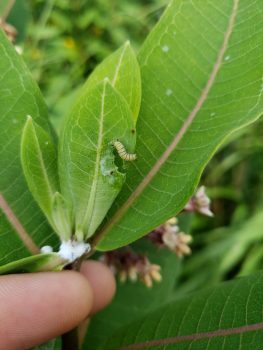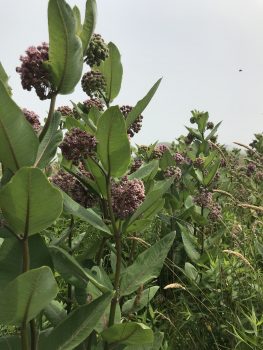Starting in 2018, the Nantucket Land & Water Council has collected Monarch butterfly data weekly each summer from a milkweed patch in Tom Nevers fields as part of a nationwide data collection program. The patch, about 400 square ft, has been left untouched while the grass around it is mowed regularly. As a result, it serves as a habitat for Monarchs, who rely heavily on milkweed for survival as their sole food source. Each plant is searched carefully, with the goal of tracking the abundance of Monarchs in each stage of their development; from egg to larva (the caterpillar as it grows and changes into five distinct larval stages, known as instars) to adult butterfly. These numerical records, as well as descriptions of the habitat they live in, are sent in to the Monarch Larvae Monitoring Program to become part of a national database. 
The push for this data collection comes from a concern about the decrease in Monarch butterflies nationally. The Monarch’s population has declined rapidly over the last two decades, due to habitat destruction as harmful pesticides like Roundup wreak havoc on milkweed populations. Additionally, climate change and resulting severe weather conditions like droughts and storms threaten Monarchs’ survival.The species is rendered especially vulnerable by their dependence on environmental cues to tell them when to migrate, hibernate, and reproduce.
This summer’s data collection kicked off with a trip to an exceptionally fog gy Tom Nevers with NLC Resource Ecologist RJ Turcotte, NLC Executive Director Emily Molden, and NLC intern Sophia Oomen-Lochtefeld. Although 2018 proved to be an abundant year for monarch butterflies, with a boom in population that almost doubled from 2017, our initial findings were scarce. Milkweed bugs and a variety of other insects, including bumble bees, were plentiful. In recent weeks, we have detected a large increase in the number of Monarch larvae at the site and are excited to see what the rest of the season brings.
gy Tom Nevers with NLC Resource Ecologist RJ Turcotte, NLC Executive Director Emily Molden, and NLC intern Sophia Oomen-Lochtefeld. Although 2018 proved to be an abundant year for monarch butterflies, with a boom in population that almost doubled from 2017, our initial findings were scarce. Milkweed bugs and a variety of other insects, including bumble bees, were plentiful. In recent weeks, we have detected a large increase in the number of Monarch larvae at the site and are excited to see what the rest of the season brings.
So what can we all do to help stop the decline of monarchs? Planting milkweed and working to conserve and restore existing patches is essential to their survival. Additionally, a decrease in the use of harmful pesticides like Roundup will slow their habitat destruction and help the well-being of a variety of other species. The Nantucket Land & Water Council also recommends using native plantings and pollinators in your landscape and home gardens to encourage these species’ survival.
